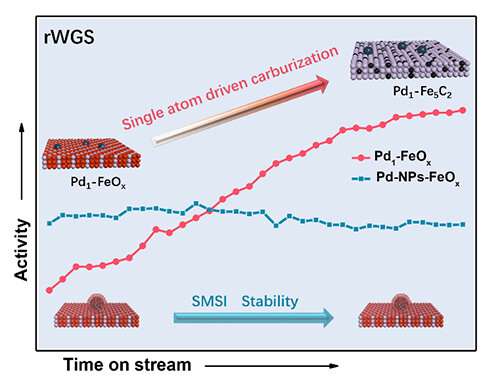Single-atom-driven dynamic carburization boosts CO2 conversion during long-term reaction

Single-atom catalysts (SACs) are a new type of heterogeneous catalysts due to their ultimate efficiency of metal atom use and unique activity/selectivity compared with nanoparticle catalysts.
Current studies in SACs focus on the specific activity and selectivity of the single active sites, the distinct reaction mechanisms in real reactions are still unclear.
Recently, a research group led by Prof. Zhang Tao and Assoc. Prof. Yang Bing from the Dalian Institute of Chemical Physics (DICP) of the Chinese Academy of Sciences (CAS), in collaboration with Prof. Zhu Beien from Shanghai Institute of Applied Physics of CAS, revealed a novel mechanism of SACs in real reactions.
"Besides providing single active sites, the Pd SACs could also promote the dynamic carburization of FeOx surface over long-term reaction during CO2 conversion, leading to remarkably enhanced reverse water-gas shift activity and CO selectivity," said Prof. Yang.
This study was published in Chem on Sept. 12.
The researchers found that Pd1-FeOx SACs promoted sustained carburization of FeOx surface over long-term reaction with increasing reverse water gas shift activity (from 17% to 28%) and CO selectivity (>98 %). By contrast, Pd-NPs-FeOx (~4nm Pd nanoparticles) possessed excellent stability during the entire time-on-stream test with CO2 conversion remaining at ~20%.
Moreover, they reported an unexpected role of Pd1 single atoms. The Pd single atoms not only provided single active sites by activating surface oxygen species at the initial stage, but also promoted dynamic carburization of FeOx surface to achieve highly active Fe5C2 phase and diminish active barriers to 27.7 kJ/mol over long-term reaction, far beyond that of previously reported Fe-based catalysts. In comparison, carburization was inhibited on Pd nanoparticle catalyst by a rapid FeOx encapsulation during the initial reaction via strong metal-support interaction.
"This work improves the general understanding of the reaction mechanism of SACs," said Prof. Yang. "The role of single atoms is not only to provide single active sites but to promote the formation of highly active phase of heterogenous catalysts during real reactions, and both roles should be considered in rational design."
More information: Pengfei Du et al, Single-atom-driven dynamic carburization over Pd1–FeOx catalyst boosting CO2 conversion, Chem (2022). DOI: 10.1016/j.chempr.2022.08.012
Journal information: Chem
Provided by Chinese Academy of Sciences




















